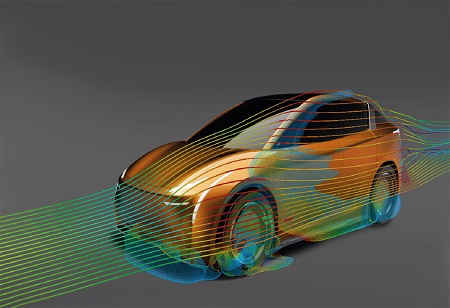
The expectations of customers and engineers from automobile industry are soaring as a result of technological improvement. This man-made device, which was created to facilitate our commute, is almost a masterpiece of engineering. Automobiles that were unimaginable 20 years ago are currently being built by engineers with the help of current technical advancement. While all of this is possible through Computer-Aided Engineering (CAE), it can also be attainable by incredibly effective method known as computational fluid dynamics, or CFD. However, creating and testing real prototypes takes a lot of time and money, therefore early in the development process, auto manufacturers and their suppliers use CAE simulations to virtually prototype and experiment. Computational fluid dynamics (CFD) is one of the most important CAE subfields.
A wide range of unlikely or unique use cases, complicated and congested assemblies, extreme environmental conditions, and other difficult-to-test circumstances can all be accurately modeled using CFD. CFD has become an integral aspect of the development process in the automobile sector since every component of a vehicle contains complicated interactions with liquids, gases, thermal transfer, and chemical reactions. Here are five areas where auto manufacturers can include CFD simulations into their development processes to learn more about how to innovate more successfully.
A sports car's aerodynamic characteristics are very different from a semi's or a minivan's. An eco-friendly design for city driving may appeal to one market group, but may not be necessary for another, such as a tough, heavy-duty pickup truck.
CFD simulates numerous aspects of how aerodynamic forces impact a vehicle. Aerodynamic drag is a horizontal force that opposes the car's forward motion and has an impact on both speed and fuel economy. Aerodynamic lift is a vertical force that can cause a vehicle to lose touch with the ground in automobile design, which could lead to an accident. Aeroacoustics, in the end, deals with the noise that a design produces.
Engineers can assess whether the impact of these adjustments will fulfil performance criteria by using CFD to estimate the impact alterations will have on a vehicle's aerodynamics.
The performance of a vehicle's tyres, which are the only component in touch with the road, is essential for its handling and performance. The materials used and the tread design, among other things, can affect how a tyre performs in hot or cold weather, how much grip it offers, and, most importantly, how it reacts in inclement weather.
The branch of tyre engineering known as hydrodynamics studies how fluids move through tyre treads. The risk of hydroplaning can be decreased by designing tyre treads to divert liquids out of the way of the tyre path. CFD produces precise models of the behaviour of fluids under tyre treads that enable engineers to enhance performance under diverse weather situations.
In a car, the way the air moves around is crucial to how comfortable the passengers are. But ensuring that air flows through the cabin in the proper direction and at a suitable pace is a challenging issue. The positioning and angle of air vents, as well as the design of the ducts leading up to the vents and the interior of the cabin, all play a significant role in how warm and cold air behave. Finally, demister vents, which keep the windscreen clear of ice and fog, are a crucial part of driver safety.
It would be challenging to adjust each of these vents individually for a variety of usage situations using a prototype. However, CFD simulations can do numerous tests in a short amount of time, enabling designers to test out more layouts without incurring additional costs.
CFD solutions for these particular use cases will be more and more crucial as the share of electric vehicles in the automotive sector grows. Thermal transfer, liquid coolant flow, and gearbox lubrication are all modelled using CFD.
CFD has additional uses in noise reduction, ensuring that the electric engine's parts run quietly and effectively inside the structural housing.
The batteries that power electric vehicles are under more engineering scrutiny as they make up a growing share of the automotive market. The performance, sustainability, and cost of a car can all be significantly impacted by improvements to a battery's operation.
Battery performance is impacted by the heat produced by current flow inside the battery cells. In addition to enhancing performance, proper heat management can also lengthen the battery's lifespan. CFD simulates the heat transfer control of a battery design under normal operating settings as well as under extremely hot or cold climatic conditions.
With CFD, you can examine all of the streamlines along with the corresponding airspeed at each location and the entire pressure field surrounding your object of study. You can even analyze the force operating on the minutest portion of your car. You cannot obtain such data with such ease, not even in the wind tunnel with the best equipment in the world. And, this will lead to a better project and a track weapon.
We use cookies to ensure you get the best experience on our website. Read more...